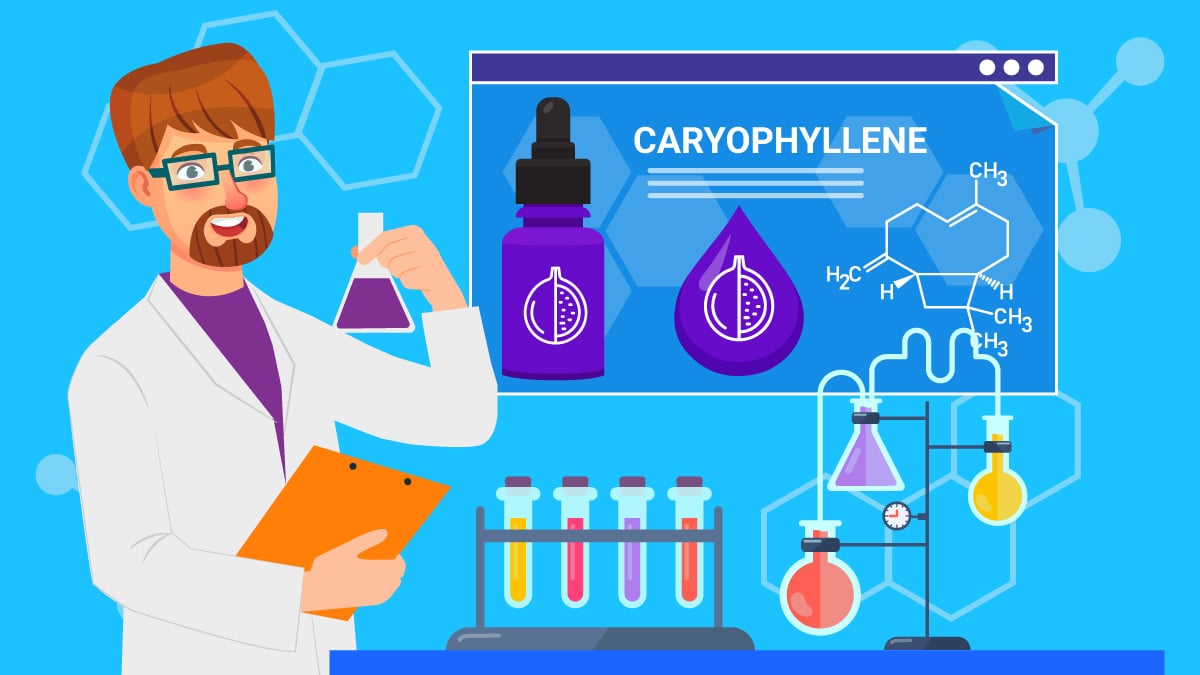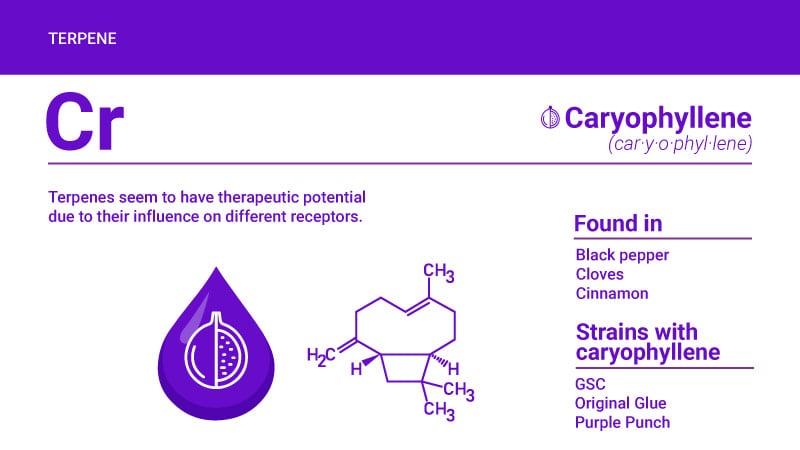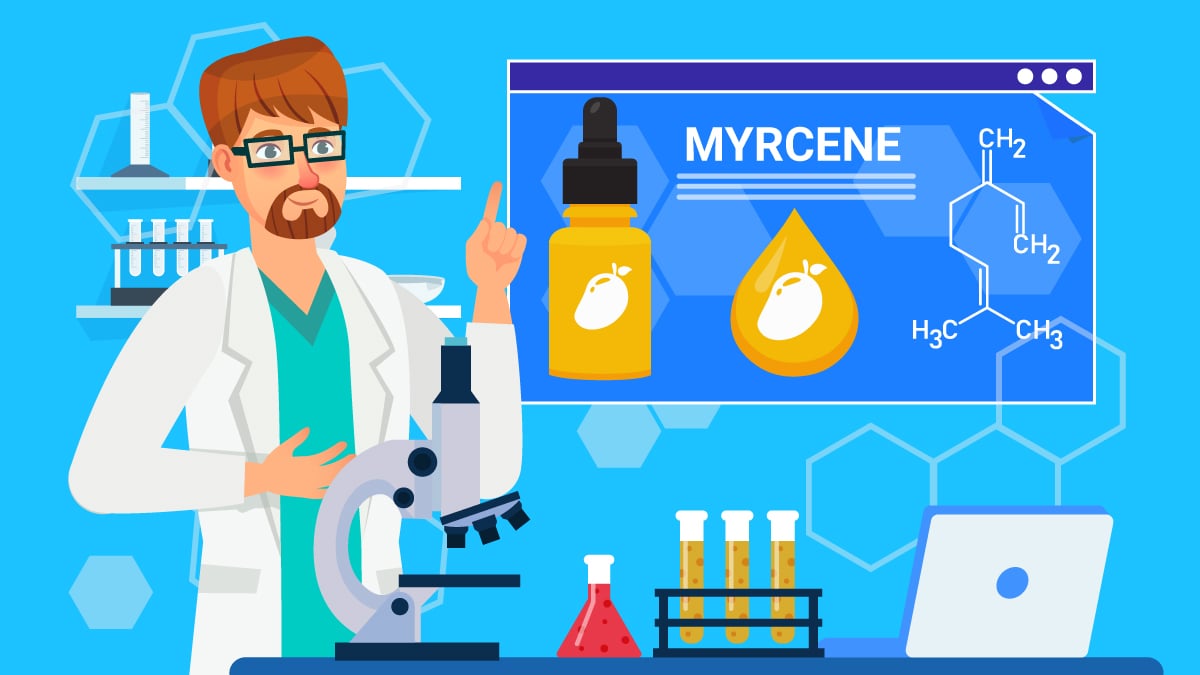Caryophyllene Terpene: Strains, Effects, Dosage, & More

Caryophyllene is one of the many terpenes found in the cannabis plant. This includes both hemp and marijuana.
This terpene has a long list of health benefits and has even been shown to enhance the effects of certain cannabinoids directly.
Here, we’ll explore what makes this spicy cannabinoid so popular today, what it’s used for, and where to buy it.
What is Caryophyllene?
Also referred to as beta-caryophyllene, this unique compound acts as both a terpene and cannabinoid.
It also lends its sharp, peppery, spicy aroma to the products it’s infused with.
Caryophyllene is a bigger molecule than other terpenes and contains a cyclobutane ring in its molecular structure — this is rare in nature and not found in any other known cannabis-derived terpenes.
Caryophyllene’s unique molecular structure allows it to bind to endocannabinoid receptors (CB1 and CB2 receptors) — providing many additional benefits most other terpenes can’t offer.
What Does Caryophyllene Smell Like?
Caryophyllene is present in many different spices and herbs, including black pepper, oregano, and basil. It’s spicy with hints of cinnamon and diesel.
Cannabis strains rich in caryophyllene deliver a peppery, warm aroma.
Many describe the smell and flavor of caryophyllene-rich cannabis as pungent because of the fuel-like undertones these strains tend to possess.
What Are the Effects of Caryophyllene?
Caryophyllene binds successfully to CB2 receptors — the part of our endocannabinoid system that regulates the immune system [1].
Because of this unique ability, caryophyllene has been found to offer the following benefits:
- Supports the immune system
- Promotes digestive health
- May help alleviate chronic pain
- May help reduce inflammation
- Provides a gentle, soothing, relaxing effect
Plants That Contain Caryophyllene
Beta-caryophyllene is naturally occurring in many plants, herbs, and spices. It produces chemicals that act on an insect’s sensory receptors, preventing it from navigating around the plant effectively. It’s almost as though the insects become drunk — unable to walk straight.
This makes caryophyllene an excellent option for repelling mosquitos and other similar bugs. DEET is comparable to a synthetic version of insect-repelling terpenes.
You can find our top-quality blended terpenes by cannabis strains HERE.
Plants that contain caryophyllene include:
- Basil
- Black caraway
- Black pepper
- Cannabis
- Cinnamon
- Copaiba oil
- Coves
- Hops
- Lavender
- Malabathrum
- Oregano
- Rosemary
- Ylang-ylang
How Common is Caryophyllene in Cannabis?
Caryophyllene is found in many cannabis strains but is quite prominent in cookie strains like Platinum Cookies, Girl Scout Cookies, and Cookies & Cream.
Next time you get any of these strains, take a good smell — you’ll notice those warm black pepper notes.
Cannabis strains with high levels of caryophyllene are typically spicy and musky, and some have a more funky, unique profile. Many strains rich in caryophyllene give off that same kick you get after smelling black pepper.
Cannabis Strains That Contain Caryophyllene
- Bubba Kush
- Sour Diesel
- Chemdog
- Candy Land
- White Widow
- OG Kush
- The White
- Cookies and Cream
- Gelato
- Platinum Cookies
- Girl Scout Cookies
- Master Kush
Caryophyllene Research
This terpene is a jack-of-all-trades when it comes to its health-boosting potential. Some studies have suggested that beta-caryophyllene can improve wound healing [2], influence insulin secretion and reduce those associated complications [3], and help calm nerves [4].
In 2014, one study revealed potential pain-relieving properties on mice [5].
Caryophyllene has also shown promise in antioxidant and anti-inflammatory properties and could be a potential option for mitigating symptoms of inflammatory bowel disease [4,7].
Research has even suggested that it may be suitable for boosting your mood [8].
Perhaps most interesting of all, panda behavior prompted a study on the possible effects caryophyllene might have on cold tolerance in mammals. Because this terpene interacts with molecular temperature sensors, it might increase mammals’ ability to withstand freezing temperatures [9].
The Chemical Structure of Caryophyllene
Beta-caryophyllene is classified as a bicyclic sesquiterpene, which makes it most closely related to terpenes such as alantolactone, artemisinin, cadinene, chamazulene, nootkatone, and santalol.
Other sesquiterpenes that share similarities to beta-caryophyllene include bisabolol, guaiol, humulene, nerolidol, valencene, and more.
This natural bicyclic sesquiterpene has two rare features: a cyclobutane ring and a trans-double bond in a 9-membered ring.
The stereocenter is adjacent to the exocyclic double bond and has an S configuration, while the other stereocenter has an R configuration.
Beta-Caryophyllene-Specs:
- IUPAC Name: (1R,4E,9S)-4,11,11-trimethyl-8-methylidenebicyclo[7.2.0]undec-4-ene
- Type of terpene: Bicyclic Sesquiterpene
- Molecular Formula: C15H24
- Molecular Weight: 204.35
- Solubility: Insoluble in water
- Boiling Point: 264ºF
Does Caryophyllene Get You High?
Caryophyllene’s unique molecular structure allows it to bind to CB2 receptors.
However, caryophyllene by itself is not a psychoactive substance. Terpenes don’t interact with our endocannabinoid receptors the same way cannabinoids do. You may feel a little calmer and a bit more positive, but it’s nothing at all like being high.
THC is not the only thing you need to look for when searching for potent buds and a pleasant high. Terpenes pack incredible flavor into your weed and provide effects that can modify the whole experience.
While many people use THC to reduce stress, some end up feeling an overwhelming sense of anxiety and paranoia. The combination of THC, CBD, and terpenes can mellow out the anxious feelings keeping you cool, calm, and collect.
Related: Do Terpenes Get You High?
Summary: What Makes Caryophyllene Special?
Caryophyllene is one-of-a-kind because this terpene can directly activate cannabinoid receptors, especially CB2.
It’s also known for producing some degree of relaxation and can effectively soothe nervous behavior. This special terp is found not only in cannabis but also in cinnamon, cloves, rosemary, hops, and black pepper. It has a distinct, spicy, warm, peppery flavor and aroma but has hints of gas or fuel when talking about its presence in cannabis strains.
Beta-caryophyllene can cause some potential health-boosting effects, but more research is needed. The more we continue to learn and grow our knowledge on terpenes, the closer we are to unlocking their full potential and health benefits.
References:
- Chicca, A., Caprioglio, D., Minassi, A., Petrucci, V., Appendino, G., Taglialatela-Scafati, O., & Gertsch, J. (2014). Functionalization of β-caryophyllene generates novel polypharmacology in the endocannabinoid system. ACS chemical biology, 9(7), 1499-1507.
- Koyama, S., Purk, A., Kaur, M., Soini, H. A., Novotny, M. V., Davis, K., … & Mescher, A. (2019). Beta-caryophyllene enhances wound healing through multiple routes. PloS one, 14(12), e0216104.
- Hashiesh, H. M., Meeran, M. F., Sharma, C., Sadek, B., Kaabi, J. A., & Ojha, S. K. (2020). Therapeutic potential of β-caryophyllene: A dietary cannabinoid in diabetes and associated complications. Nutrients, 12(10), 2963.
- Machado, K. D. C., Paz, M. F. C. J., Oliveira Santos, J. V. D., da Silva, F. C. C., Tchekalarova, J. D., Salehi, B., … & Cavalcante, A. A. D. C. M. (2020). Anxiety Therapeutic Interventions of β-Caryophyllene: A Laboratory-Based Study. Natural Product Communications, 15(10), 1934578X20962229.
- Klauke, A. L., Racz, I., Pradier, B., Markert, A., Zimmer, A. M., Gertsch, J., & Zimmer, A. (2014). The cannabinoid CB2 receptor-selective phytocannabinoid beta-caryophyllene exerts analgesic effects in mouse models of inflammatory and neuropathic pain. European Neuropsychopharmacology, 24(4), 608-620.
- Al Mansouri, S., Ojha, S., Al Maamari, E., Al Ameri, M., Nurulain, S. M., & Bahi, A. (2014). The cannabinoid receptor 2 agonist, β-caryophyllene, reduced voluntary alcohol intake and attenuated ethanol-induced place preference and sensitivity in mice. Pharmacology Biochemistry and Behavior, 124, 260-268.
- Bento, A. F., Marcon, R., Dutra, R. C., Claudino, R. F., Cola, M., Leite, D. F. P., & Calixto, J. B. (2011). β-Caryophyllene inhibits dextran sulfate sodium-induced colitis in mice through CB2 receptor activation and PPARγ pathway. The American journal of pathology, 178(3), 1153-1166.
- Bahi, A., Al Mansouri, S., Al Memari, E., Al Ameri, M., Nurulain, S. M., & Ojha, S. (2014). β-Caryophyllene, a CB2 receptor agonist produces multiple behavioral changes relevant to anxiety and depression in mice. Physiology & behavior, 135, 119-124.
- Zhou, W., Yang, S., Li, B., Nie, Y., Luo, A., Huang, G., … & Wei, F. (2020). Why wild giant pandas frequently roll in horse manure. Proceedings of the National Academy of Sciences, 117(51), 32493-32498.



